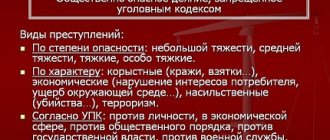Collateral concept
The concept of pledge is enshrined in Art. 106 of the Code of Criminal Procedure of the Russian Federation. It consists of transferring property or funds to the body investigating a criminal case or the court as a guarantee of ensuring the person’s appearance before the investigative body or court, as well as guaranteeing his proper behavior.
Initially, the term “pledge” was used in civil law and defined the interaction between individuals and organizations. But over time, the term began to be used in the context of criminal procedural relations, denoting a slightly different aspect.
Although the procedure for applying the institution of bail is determined by both the Code of Criminal Procedure and the Civil Code, for the purposes of criminal proceedings the Code of Criminal Procedure of the Russian Federation has priority. The Civil Code regulates the mechanism of bail in criminal proceedings only in aspects not regulated by the Code of Criminal Procedure of the Russian Federation.
Subject and content of the pledge
The subject of the pledge may be:
- apartment, house, other real estate;
- cash, stocks and bonds, the circulation of which is permitted within the country.
All property, except money, is accepted as collateral only if documents confirming ownership and absence of encumbrance are provided. Property that cannot be foreclosed on is not accepted as collateral.
Not all types of encumbrances are subject to state registration. Therefore, the person who makes the deposit is required to provide a written receipt indicating that there is no encumbrance.
The measure of restriction can be replaced by bail at any time until a decision is made in the case. A copy of the document is given to the suspect (accused).
If bail was chosen by a court order as a preventive measure before sending the case materials to the court, then the property or funds are accepted by the body conducting the investigation.
If this happened after the materials were sent to the court, the bail is accepted by the court.
In any case, the fact of making a deposit is recorded in the protocol, and a copy of it is given to the person who deposited the funds.
The maintenance of the collateral is ensured by the body that accepted the property.
Refund of deposit
The bail is returned after the verdict has acquired legal force or ten days after the investigative body issues a decision to terminate the criminal prosecution.
Any final procedural decision must contain a clause on the return of funds or real estate. If the verdict forgot to indicate information about the fate of the collateral, write a corresponding statement.
The process is carried out in the department of the judicial department at the Supreme Court of the constituent entity of the Russian Federation, where you must come with a legally binding decision.
In addition, you must have with you:
- passport of the mortgagor;
- payment document confirming the transfer of money to the deposit;
- bank account details;
- return application.
Funds are transferred by bank transfer within a month.
Those citizens who are faced with difficulties should not despair. Enlist the support of a lawyer who will provide the necessary assistance, advise, draw up the necessary documents, represent your interests, and perform the work in accordance with the requirements of the law and the client.
The importance of bail as a preventive measure
In recent years, there has been a trend in Russia of a shortage of places to hold convicted people. New premises are not being built, and the number of crimes is not decreasing. In this regard, the courts practice the appointment of other measures that are not related to being in pre-trial detention centers and prisons. This includes house arrest, recognizance not to leave, and bail. For ordinary citizens, bail is not a priority measure, since the amounts assigned by the court are often prohibitive, and not everyone has the opportunity to mortgage real estate. Thus, bail is used mainly in relation to wealthy members of society.
In criminal proceedings, bail is used as a measure of restriction of rights, guaranteeing that the suspect or accused will come, if necessary, to the employees of the body investigating the crime or to court. Many experts recognize bail as the most stringent measure after restriction of freedom, since a person risks material wealth, and the amount of bail is, as a rule, quite significant.
For the Russian system, bail as a preventive measure is also confirmation of compliance with international law. One of the acts provides for a person’s right to a preventive measure that does not involve isolating him from society, but guarantees that he will be present at the hearing of the case in court.
Bail as a preventive measure against a suspect can be assigned for 10 or 45 days, depending on the qualifications of the crime. If during this time the suspect changes his status to accused, the preventive measure continues to be in effect until a decision is made on the case. If charges are not brought, and the period for which the rights and freedoms of the suspect may be limited expires, then the bail is returned to the pledgee.
General rules
The tools used by the state are aimed at correcting, isolating and controlling the behavior of individual citizens. Restrictive measures are applied for a variety of reasons.
They are necessary to prevent:
- committing new criminal acts;
- opportunities to abscond from justice;
- obstructing the investigation;
- destruction of evidence;
- intimidation of witnesses, victims, and other participants in the process.
The decision is made specifically for each accused in accordance with the documents provided.
Investigators, prosecutors, courts, lawyers are subject not only to legal norms, but also to common sense, have excellent intuition, and the basics of psychology. Therefore, they carefully study the circumstances of the offense committed and the person’s personality.
Signs to look out for first:
- The gravity and motive of the act committed. It is quite natural that a murderer who has committed a deliberate crime should be isolated from society, since none of us would want to meet such a person on the street. Even if there is a serious illness or minor children in the family. A person accused of embezzlement of budget funds, as part of a group, holding a certain position in law enforcement agencies, will also be held in custody in a pre-trial detention center until a verdict is passed. This is especially true when there are direct instructions from the Government on the fight against corruption.
- The age of the accused is taken into account in conjunction with other characterizing data. Minors are supervised by relatives, guardians, and specialists from a child care institution.
- Presence of minor children, marital status. These characteristics are taken into account, as a rule, in relation to single mothers and fathers who have committed a crime of minor or moderate gravity.
- Health status. It is taken into account in conjunction with the nature of the criminal act and the degree of guilt. No one will restrict the freedom of a cancer patient in the final stages who needs constant medical support. The presence of less dangerous diseases will not play a special role in decision making.
- Occupation, position in society. If the crime committed is not related to the professional activity of a person in a certain social status in the public service, then this characteristic is taken into account when making a decision.
- Presence or absence of permanent residence. A citizen who is temporarily in Moscow for some personal or official needs will be placed in a pre-trial detention center. This is the only way law enforcement agencies will be able to ensure the smooth consideration of a criminal case. By the way, one of the reasons for the overcrowding of pre-trial detention centers is visitors, who make up more than 75% of the total population.
As a rule, a recognizance not to leave, which does not imply isolation, is applied to citizens who have committed a theft for a small amount, caused harm to the health of the victim for the motive of their own defense, and who face a suspended sentence.
Who has the right to impose a preventive measure?
Bail as a preventive measure is chosen only by the court. A preventive measure may be imposed at any time before a decision is made in the case.
In addition, a pledge can replace another measure of restriction. Usually they try to replace it with detention, since this is the most severe measure.
A petition to change the preventive measure to bail can be filed either by the person himself or by any other person or organization.
Petitions are considered by the district court at the place where the crime was committed and its investigation. It is considered even if the investigator requests another measure of restriction of freedom.
How is the amount of bail determined?
The decision on the amount in which bail must be paid is made by the court, based on the severity of the crime, the characteristics of the personality of the suspect (accused), and the financial condition of the person who will pay the funds. The Criminal Code of the Russian Federation sets lower limits:
- if the crime is of minor or moderate gravity, the amount of bail is not less than fifty thousand rubles;
- if it is serious or especially serious - not less than five hundred thousand rubles.
A person may be released on real estate bail. There are some requirements for it:
- the property must not be mortgaged or have any other encumbrance;
- It is imperative to submit original documents of ownership.
The assessment of the value of real estate must be carried out no earlier than 5 days before filing a petition with the court.
Consideration of the petition must be carried out with the participation of both parties, and the suspect (accused) has the opportunity to express his opinion.
Deposit deadline
The deadline for posting bail is also determined by the court. If a person is in custody, he remains there until bail is posted, but for no more than three days.
If another preventive measure was chosen before the bail, it is valid until the bail is posted.
If bail is not paid within the established period, the court imposes another measure of restriction.
Pledge: concept, grounds and procedural procedure for election
Bail consists of the deposit or transfer by a suspect, accused or other individual or legal entity at the stage of preliminary investigation to the body in charge of the criminal case, and at the stage of trial - to the court, of real estate or movable property or money, valuables and admitted to the public circulation of shares and bonds in the Russian Federation in order to ensure the appearance of the suspect, accused before the investigator, interrogating officer or in court, as well as to prevent him from committing new crimes.
Bail may be granted at any time during criminal proceedings.
Bail can only be set by a court decision. Considering that bail has the right to be paid by any person who has the required amount or valuables, the investigator and the court must establish the nature of the relationship between the accused and the bailor in order to prevent an illegal transaction or assistance to the accused by his alleged accomplice.
The bail must prevent all types of undesirable behavior of the suspect or accused.
The type and amount of bail are determined by the court taking into account:
- the nature of the crime committed,
- information about the identity of the suspect, accused,
- financial situation of the suspect, accused,
- property status of the mortgagor.
At the same time, in criminal cases of crimes of minor and medium gravity, the amount of bail cannot be less than 100,000 rubles, and in criminal cases of serious and especially grave crimes - less than 500,000 rubles.
Procedural order:
1. Submission of a petition for the application of bail to the court by a suspect, accused, or other individual or legal entity. The petition is submitted to the court at the place of the preliminary investigation and is required for consideration by the court along with the petition of the investigator or interrogating officer to select a different preventive measure against the same person, if the latter is received.
The Plenum of the Armed Forces of the Russian Federation in paragraph 27 of Resolution No. 22 of October 29, 2009 “On the practice of using preventive measures by courts in the form of detention, bail and house arrest” explained that if, during consideration at a court hearing, the petition of the inquirer or investigator to choose a preventive measure in In the form of detention, the court simultaneously receives a petition from the defense lawyer and the suspect or accused to set bail, then the judge, subject to recognizing the suspect’s detention as legal, considers this petition and makes a decision on setting bail. By virtue of Part 7.1 of Art. 108 of the Code of Criminal Procedure, he can make this decision on his own initiative.
2. If the decision to choose a preventive measure in the form of bail is made by the investigator or interrogating officer, then they issue a decision on this. The investigator - with the consent of the head of the investigative body, the interrogating officer - with the consent of the prosecutor (resolution to initiate a petition to the court to select a preventive measure in the form of bail).
3. Direct consideration of the petition by a district court judge alone with the participation of the suspect, accused, his defense attorney, prosecutor, within 8 hours from the moment the case is received by the court.
4. The judge makes a decision, which indicates the specific factual circumstances on the basis of which the judge made the decision:
a) issuing a resolution to select a preventive measure in the form of bail; such a resolution establishes the deadline for posting bail; if the suspect was detained, then the court, subject to recognizing the detention as legal and justified, extends the period of detention until bail is posted, but not more than 72 hours from the moment of the court decision. If bail is not posted within the specified period, the court, at the request of the investigator, interrogating officer in accordance with Art. 108 considers the issue of choosing a different preventive measure in relation to the suspect or accused. If the posting of bail is applied instead of another previously chosen preventive measure, then this preventive measure is valid until the posting of bail.
b) a decision is made to refuse to satisfy the stated petition
c) a decision is made to extend the period of detention if the conditions provided for in paragraph 3 of Part 7 of Art. 108 Code of Criminal Procedure.
As the Plenum indicated, if bail is not paid within 48 hours from the time of detention of the suspect, the judge extends the period of detention to 72 hours, and in case of failure to pay bail, considers choosing a preventive measure in the form of detention (paragraph 27).
5. Sending the judge’s decision to the person who filed the petition, the prosecutor, the suspect or the accused.
6. Explanation of the right to appeal, as well as the consequences of failure to comply with this preventive measure.
7. Drawing up a protocol on acceptance of the pledge, a copy of which is given to the pledgor. The money that is the subject of the bail is deposited into the deposit account of the court or body in charge of the criminal case.
In case of violation of the obligations related to the bail, the suspect, the accused, the bail is turned into state revenue by a court decision in accordance with Art. 118 Code of Criminal Procedure. In other cases, the court, when rendering a verdict or issuing a ruling, or a decision to terminate a criminal case, decides on the return of the bail to the pledgor.
Bail consists of the deposit or transfer by a suspect, accused or other individual or legal entity at the stage of preliminary investigation to the body in charge of the criminal case, and at the stage of trial - to the court, of real estate or movable property or money, valuables and admitted to the public circulation of shares and bonds in the Russian Federation in order to ensure the appearance of the suspect, accused before the investigator, interrogating officer or in court, as well as to prevent him from committing new crimes.
Bail may be granted at any time during criminal proceedings.
Bail can only be set by a court decision. Considering that bail has the right to be paid by any person who has the required amount or valuables, the investigator and the court must establish the nature of the relationship between the accused and the bailor in order to prevent an illegal transaction or assistance to the accused by his alleged accomplice.
The bail must prevent all types of undesirable behavior of the suspect or accused.
The type and amount of bail are determined by the court taking into account:
- the nature of the crime committed,
- information about the identity of the suspect, accused,
- financial situation of the suspect, accused,
- property status of the mortgagor.
At the same time, in criminal cases of crimes of minor and medium gravity, the amount of bail cannot be less than 100,000 rubles, and in criminal cases of serious and especially grave crimes - less than 500,000 rubles.
Procedural order:
1. Submission of a petition for the application of bail to the court by a suspect, accused, or other individual or legal entity. The petition is submitted to the court at the place of the preliminary investigation and is required for consideration by the court along with the petition of the investigator or interrogating officer to select a different preventive measure against the same person, if the latter is received.
The Plenum of the Armed Forces of the Russian Federation in paragraph 27 of Resolution No. 22 of October 29, 2009 “On the practice of using preventive measures by courts in the form of detention, bail and house arrest” explained that if, during consideration at a court hearing, the petition of the inquirer or investigator to choose a preventive measure in In the form of detention, the court simultaneously receives a petition from the defense lawyer and the suspect or accused to set bail, then the judge, subject to recognizing the suspect’s detention as legal, considers this petition and makes a decision on setting bail. By virtue of Part 7.1 of Art. 108 of the Code of Criminal Procedure, he can make this decision on his own initiative.
2. If the decision to choose a preventive measure in the form of bail is made by the investigator or interrogating officer, then they issue a decision on this. The investigator - with the consent of the head of the investigative body, the interrogating officer - with the consent of the prosecutor (resolution to initiate a petition to the court to select a preventive measure in the form of bail).
3. Direct consideration of the petition by a district court judge alone with the participation of the suspect, accused, his defense attorney, prosecutor, within 8 hours from the moment the case is received by the court.
4. The judge makes a decision, which indicates the specific factual circumstances on the basis of which the judge made the decision:
a) issuing a resolution to select a preventive measure in the form of bail; such a resolution establishes the deadline for posting bail; if the suspect was detained, then the court, subject to recognizing the detention as legal and justified, extends the period of detention until bail is posted, but not more than 72 hours from the moment of the court decision. If bail is not posted within the specified period, the court, at the request of the investigator, interrogating officer in accordance with Art. 108 considers the issue of choosing a different preventive measure in relation to the suspect or accused. If the posting of bail is applied instead of another previously chosen preventive measure, then this preventive measure is valid until the posting of bail.
b) a decision is made to refuse to satisfy the stated petition
c) a decision is made to extend the period of detention if the conditions provided for in paragraph 3 of Part 7 of Art. 108 Code of Criminal Procedure.
As the Plenum indicated, if bail is not paid within 48 hours from the time of detention of the suspect, the judge extends the period of detention to 72 hours, and in case of failure to pay bail, considers choosing a preventive measure in the form of detention (paragraph 27).
5. Sending the judge’s decision to the person who filed the petition, the prosecutor, the suspect or the accused.
6. Explanation of the right to appeal, as well as the consequences of failure to comply with this preventive measure.
7. Drawing up a protocol on acceptance of the pledge, a copy of which is given to the pledgor. The money that is the subject of the bail is deposited into the deposit account of the court or body in charge of the criminal case.
In case of violation of the obligations related to the bail, the suspect, the accused, the bail is turned into state revenue by a court decision in accordance with Art. 118 Code of Criminal Procedure. In other cases, the court, when rendering a verdict or issuing a ruling, or a decision to terminate a criminal case, decides on the return of the bail to the pledgor.
Who pays the deposit
Apart from the person involved in the criminal case, any person or organization can contribute funds.
The person is explained the essence of the case, the charges brought against the person, the circumstances due to which bail was chosen as a preventive measure, the conditions under which the person is released on bail, and the consequences that may occur in the event of their violation.
A protocol on the acceptance of property or money is drawn up, one copy is given to the person who contributed the money. If the subject of the pledge is not money, in addition to the protocol, an act of acceptance and transfer of property is drawn up.
If the pledgor is a third party, then the consent of the suspect (accused) must be obtained. This is due to the fact that it will depend on him whether the mortgagor will receive his money back.
What to do if a person was released on the security of real estate, but as a result of some circumstances the condition of the property was changed for the worse or it was alienated legally?
The Plenum provides a solution to this problem. The pledgor has the right to replace the pledged item with a similar one. If he cannot do this, the preventive measure will be changed by the court.
What is the fate of the collateral?
What is the future fate of the pledged funds or property? It depends on whether the person complied with the conditions under which he was released or not.
If the conditions were violated (failed to appear before the investigator or court, committed a crime, etc.), then the bail is transferred to the state budget and is not returned to the person.
The court verifies whether the person has violated the conditions so that the bail is not erroneously turned in favor of the state.
In all other cases, the issue of returning the pledged property or funds is resolved during the sentencing or termination of the criminal case.
When is the deposit non-refundable?
If the suspect/accused violates the conditions of the bail, for example, hides from the investigation, evades appearing in court, then the funds or valuables posted as bail are transferred to the state, and a more severe preventive measure is chosen for the person.
Thus, the deposit is not returned in case of violation of the agreement on the terms of the deposit.










